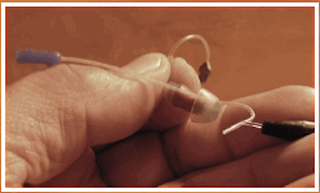That smile, really just a slight curve of the lips. Are the eyes smiling too, or just watching someone? But who, and why?
For hundreds of years, art lovers, kings and peasants have marveled at Mona Lisa’s beauty and pondered the source of the enigmatic smile. But I, immune to her romantic appeal, know why.
Mona Lisa was hard of hearing.
I know this because she is wearing “the look”. Those who understand hearing loss recognize in Ms. Lisa the face of one who has either tuned out or is only pretending to keep up with the conversation.
Think about it. Leonardo da Vinci, smitten with his model’s beauty, was painting from behind his canvas. As he prattled on about her mysterious beauty (cara mia, bella, bella!), Mona Lisa had no clue what he was saying – because she couldn’t read his lips. Not wanting da Vinci (or anyone) to know about her hearing loss, she smiled as if she understood his words of adoration and da Vinci passionately painted ‘the look’ that has become of one of civilization’s enduring icons.
Yes, Mona was bluffing, just as all people with hearing loss do, whether we admit it or not. Rather than confess we’ve dropped into the black hole of a group conversation, we adopt a benign look of understanding punctuated by the occasional half-nod that may – or may not – indicate agreement with what’s being said. While we don’t always intend to bluff, most of us are regulars who think no one knows our dark secret – that we’re as lost as ol’ Mona.
We also believe we are good bluffers when, in reality, we could learn a thing or two from Mona Lisa about personal mystery. The hard, cold fact is that anyone who knows us well enough to identify us in a police lineup, recognizes immediately when we’re bluffing.
Here are a few telltale signs of a bluffer who may only seem to be listening and understanding you. (Note of authenticity: I have personally practiced and been caught at all of the following situations.)
- The aforementioned Mona Lisa half-smile: non-committal, somewhere between a bright smile and rigor mortis.
- A single eyebrow arched slightly to indicate interest. But a brow that has been arched for too long should be a clue – do you know anyone who is interested in every single thing you say, hour after hour?
- Hands tightly laced or folded in the lap. I had always wondered why people do this, but seeing Mona Lisa’s hands, I now realize it’s a generic hearing loss trait, a sign of stress. In a stimulating conversation where one’s only contribution is a repeated “pardon?”, self-esteem suffers.
- The person startles when spoken to directly, responding with “Sorry! I must have drifted off, what were you saying?” Very suspicious, especially when they have been gazing at you calf-eyed.
- The person stands up and leaves the room while the speaker in mid-sentence. A dead give-away.
All hard of hearing people bluff to some degree and this will never change. The real problem lies in the frequency and timing of our bluffing. Some of us are occasional fakers but for others it’s a way of life. And while it pains me to see hard of hearing people tune out in a conversation, I understand the reasons: denial of hearing loss or its severity, not wanting to bother people by asking for repetition, or what we dread above all else, making inappropriate remarks at the wrong time.
My personal, most common, rationale for adopting for ‘the look’, is that struggling to keep up takes a lot of concentration and energy! Sometimes it’s just easier to tune out for a minute or two, especially in difficult listening environments such as busy restaurants, fast-paced group conversations, noisy family gatherings, or any event where it’s hard to follow the conversation.
I’ve learned the hard way that bluffing can get me into serious trouble. Once, during a night time beach stroll with a developing romantic interest, he asked me a question. It was dark, the waves were loud, and I didn’t catch it. I must have asked him to repeat himself once too often that night, because I took a guess and answered “no”. He stopped in his tracks. “No!?” he asked, astounded. Uh-oh, I thought, this was important. But I’d gone too far and my pride made me firmly repeat, “No”.
End of relationship; never saw that nice guy again. And to this day, I have no idea what he asked me. But I can guess:
Nice Guy: I like you, Gael. Do you like me?
Gael: No.
Nice Guy: Really? You don’t want to keep seeing me?
Gael: No.
Because I was afraid of looking foolish, I lost something special. (All’s well that ends well, however, because I eventually married a wonderful guy. But you always wonder what might have been.)
I’ve become assertive about my hearing loss and what I need to communicate. But it has been a lifelong process; for most of us, this comfort level isn’t reached overnight. From time to time, we just give in to our inner Mona Lisa and do the bluff thing. I’ll tell myself “this is too difficult, I’m just going to let this one pass”, because some situations are beyond my control. I can express my needs, but I can’t force others to adopt better enunciation and eye contact, I can’t eliminate all background noise, and I can’t keep everyone from people talking at once.
So for those times when I find it tough to follow what’s being said, what’s a girl gonna do?
Smile slightly, arch my left eyebrow, fold my hands in my lap, and hope like hell that no one asks me a direct question. And who knows? Perhaps someone will feel compelled to paint my mysterious beauty for the third millenium to wonder at.







Hello Gael:
Thanks for another entertaining blog with an important message, and now, we all know Mona’s secret. LOL!
Thats one of the best articles about the problems and the way to survive of deaf or hard of hearing people I read in a long long time. Thanks a lot 🙂
What a refreshing way to say ‘it’! LOL. Great blog Gael! Have fun at the HLAA convention. I’m really bummed I won’t be there this year. I’ll miss the ‘no need to bluff’ environment! Be sure to record some of the ‘elevator conversations’. My hearing husband, who has attended with me a few times, always found them quite entertaining. 🙂
Gael – Hearing loss or not, I think you are wiser, wittier, and prettier than that famous woman who posed for a painting. So what if you occasionally bluff! Great post.
The text is, at the same time, inspiring and refreshing. It contains several elements filled with so much truth… you’re very talented Gael!
This is delightful, Gael! Thank you!
Wow! You did a beautiful job of nailing this! I’m so glad to see that I’m not the only one who “bluffs” her way through conversations. I just love your take on this issue. :o)
Laughing. You hit it dead on! I’ll never look at Mona Lisa again without thinking,”Hey Mona, I know (and share) your secret.”
Also, “…hearing loss trait, a sign of stress. In a stimulating conversation where one’s only contribution is a repeated “pardon?”, self-esteem suffers,” is so true – and the stress wears ya out -and down!
I will copy, print and forward this to a few of the many hearing who never seemed to “get it”
Thanks for such a innovative, creative piece on so many levels.
Jim and I just got T-shirts for the SWC silent auction. They say:
“I’m just going to NOD and act like I’m LISTENING!”
Oh yes! Mona had no clue. But Gail, this is nother great one for we folks who read lips.
OK, Gael, ‘fess up; who is your ghostwriter? 🙂
Great article!
WOW!! Very nice job. I agree with those above, will never look at that painting the same way. Very well written Gael.
great article! i literally laughed out loud at a couple of those moments, your poor suitor…
well said!!